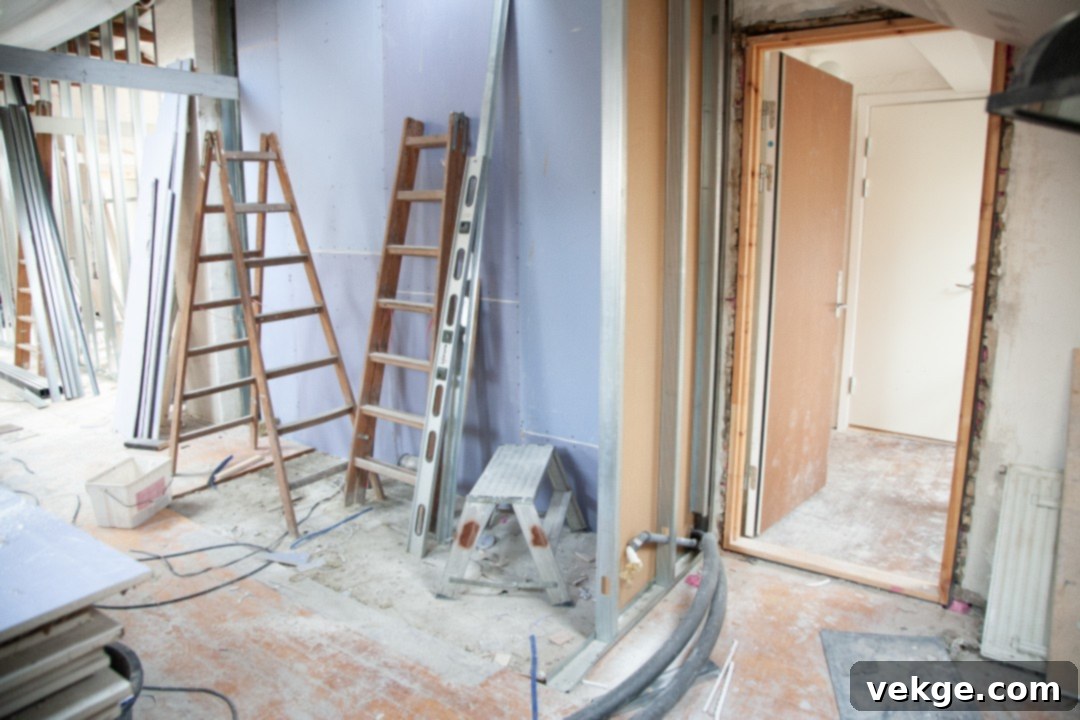Mastering Your Home Renovation: An Essential Guide to Planning for Success
The allure of a transformed living space is incredibly powerful. Imagining updated aesthetics, enhanced functionality, and increased home value can easily lead us to dream big about home renovation projects. The promise of new possibilities is undeniably exciting, making it tempting to dive straight into demolition and design. However, embarking on a renovation journey without meticulous forethought and careful consideration is akin to sailing without a map. While the end result can be incredibly rewarding, the path to achieving it is often fraught with potential pitfalls and unexpected challenges.
A successful home renovation isn’t just about picking the right paint color or the trendiest fixtures; it’s about a comprehensive planning process that anticipates every aspect, mitigates risks, and ensures the project’s smooth execution from conception to completion. This guide will walk you through the most critical factors you must consider before lifting a single hammer, providing you with the insights needed to navigate your renovation journey with confidence and achieve truly remarkable results.
Budgeting Your Renovation: The Financial Foundation
For most homeowners, the financial aspect is the bedrock of any renovation. Before you even start sketching designs or browsing material samples, you need a clear, realistic understanding of how much you can comfortably afford to spend. This foundational figure will inform every subsequent decision, from the scope of your project to the quality of materials and the contractors you can engage. A well-defined budget isn’t a restriction; it’s a powerful tool that helps you set achievable goals and avoid costly overruns.
When creating your budget, it’s crucial to account for all potential expenses. Beyond the obvious costs of materials and labor, remember to factor in design fees for architects or interior designers, permit application fees, and potential survey costs. Don’t forget about professional services like electricians, plumbers, and structural engineers, which are often integral to larger projects. Moreover, always allocate a significant contingency fund – typically 10% to 20% of your total budget – for unexpected expenses and complications. Even the most meticulously planned projects can encounter unforeseen issues, from discovering asbestos behind a wall to needing a structural repair that wasn’t initially visible. This contingency acts as your financial safety net, preventing stress and project delays.

It’s tempting to opt for the lowest quote from contractors or the cheapest materials, but remember that value isn’t always synonymous with the lowest price. Weigh the cost against the quality of materials, the reputation and experience of contractors, and the long-term durability of the work. Sometimes, investing a little more upfront can save you significant repair costs down the line. Explore various financing options, whether it’s utilizing personal savings, securing a home equity loan, a personal loan, or even refinancing your mortgage. Understand the interest rates and repayment terms associated with each option to make a financially sound decision for your renovation.
Navigating Planning Permission and Building Regulations
Before any physical work commences, a critical step is to familiarize yourself with the planning permission requirements and building regulations in your specific area. These are distinct but equally important legal frameworks that govern construction and renovation work. While minor interior cosmetic renovations often don’t require planning permission, significant changes to your home’s structure, exterior appearance, or footprint almost certainly will.
**Planning permission** primarily concerns the aesthetic impact and use of your property in its local environment. Projects like extensions, adding a new storey, converting a garage into a living space, or making significant changes to your property’s façade (e.g., new windows that alter the original look) typically fall under this category. Regulations are especially stringent for properties located in conservation areas or those that are listed buildings, where even minor alterations might require specific consent to preserve historical character. Ignoring planning permission requirements can lead to enforcement notices, hefty fines, and even the costly demolition of unauthorized work.
**Building regulations**, on the other hand, focus on the structural integrity, safety, energy performance, and accessibility of your building. This includes aspects like foundations, damp-proofing, insulation, ventilation, fire safety, and sanitation. Nearly all structural alterations, new electrical installations, plumbing work, or changes affecting energy efficiency will need to comply with building regulations, even if they don’t require planning permission. You’ll need to ensure your plans meet these standards and usually require inspections by your local authority’s building control team at various stages of the work.
Engaging with your local council and relevant authorities early in your planning process is not just a formality; it’s a proactive measure that can save you from significant legal complications, costly redesigns, and time-consuming setbacks. Pre-application advice can be invaluable, offering guidance on whether your project is likely to be approved and what specific documentation you’ll need.
Understanding Home Insurance Implications
Your home insurance policy is a crucial safety net for your property, but its terms and conditions are closely linked to your home’s condition, structure, and use. Embarking on a renovation project can significantly impact your coverage, and failing to inform your insurer could render your policy void, leaving you financially exposed in the event of an incident.

Major renovation work introduces new risks that your standard policy might not cover. These include an increased risk of theft (materials, tools), accidental damage to the property or neighboring properties, and public liability issues if a worker or visitor is injured on your site. For significant projects, your insurer might require you to upgrade your existing policy, or you might need to take out specialized “contractor’s all-risk” insurance, which typically covers damage to the works themselves, materials, and equipment. Your chosen contractors should also hold adequate public liability and employer’s liability insurance; always ask for proof of this.
It’s vital to communicate your renovation plans with your insurer well in advance. Be prepared to provide details about the nature of the work, the estimated timeline, the value of the materials, and whether you will be vacating the property during the renovation. Some policies may have clauses about unoccupied properties, so if you move out, you might need temporary vacant property insurance. Think of your insurance as a critical safety net, protecting your property and the substantial investment you’re making, whether unforeseen issues arise before, during, or after the project.
Future-Proofing Your Home: Investing in Tomorrow
As you plan your renovations, broaden your perspective beyond your immediate needs. Consider how your home might need to evolve to accommodate future changes in your lifestyle, family dynamics, and technological advancements. Future-proofing your home isn’t just about increasing its resale value; it’s about enhancing its long-term functionality, adaptability, and sustainability, ensuring it remains a comfortable and efficient space for years to come.
Think about flexible spaces that can adapt to changing demands – a spare bedroom that can function as a home office, a children’s playroom, or an accessible guest room. Consider integrating smart home technology during the renovation; wiring for smart lighting, climate control, security systems, and high-speed internet is far easier and more cost-effective when walls are open. Energy efficiency is another crucial aspect of future-proofing. Upgrading insulation, installing energy-efficient windows, or incorporating renewable energy sources like solar panels can significantly reduce utility bills and your carbon footprint, adding substantial long-term value.
Accessibility is also an important consideration, particularly for aging in place or accommodating family members with mobility challenges. Simple additions like wider doorways, curbless showers, or the strategic placement of electrical outlets can make a huge difference. Incorporating these elements into a wider renovation project often softens the financial blow, as you can leverage materials and labor already on site. A slight adjustment to your chosen funding method, whether a personal loan or cash reserves, might make these beneficial “extras” more easily achievable, leading to a home that truly serves your family’s needs for decades.
Selecting the Right Professionals: Architects, Builders, and Designers
The success of your renovation project ultimately hinges on the quality and reliability of the team you assemble. From architects who translate your vision into technical drawings to skilled builders who execute the work, and interior designers who refine the aesthetic, choosing the right professionals is paramount. Working with reputable, experienced individuals and companies ensures that the work completed is of high quality, structurally sound, and built to last.

Begin by conducting thorough research. Look for professionals who specialize in projects similar to yours and who have a strong portfolio of completed work. Seek recommendations from friends, family, or online communities. Professional bodies, such as the Federation of Master Builders, can also provide lists of vetted contractors. Once you have a shortlist, request multiple detailed quotes, ensuring each one specifies the scope of work, materials included, estimated timeline, and payment schedule. Remember that the cheapest quote isn’t always the best; consider the overall value, including reputation, experience, and the contractor’s insurance and licenses.
Meeting face-to-face with potential contractors is essential. This allows you to discuss your vision, assess their communication style, and get a feel for their professionalism and reliability. Don’t hesitate to ask for references and follow up on them. Speak to previous clients about their experience with the contractor, paying attention to aspects like adherence to budget and timeline, quality of work, and how they handled unexpected issues. Crucially, ensure a comprehensive written contract is in place before any work begins. This document should clearly outline everything from start and end dates to payment milestones, change order procedures, and dispute resolution mechanisms. A clear contract protects both you and your chosen professionals, setting clear expectations for a smooth and successful renovation.
Timeline Management and Logistics: Realistic Expectations
Beyond the financial and legal aspects, a realistic understanding of the timeline and logistical challenges of your renovation is crucial. Projects rarely run precisely to schedule, so building in buffer time for unexpected delays – such as material delivery issues, unforeseen structural problems, or adverse weather conditions – is always a wise approach. Discuss the project timeline in detail with your contractors and agree on key milestones.
Consider the disruption that renovation work will cause to your daily life. Will you need to move out temporarily? If so, factor in the cost of alternative accommodation. Even for less disruptive projects, expect noise, dust, and limited access to certain areas of your home. Plan for temporary utility shut-offs and ensure you have clear communication channels with your team to stay informed about progress and any changes to the schedule. A well-managed timeline, coupled with realistic expectations, can significantly reduce stress throughout the renovation process.
Design & Aesthetics: Harmonizing Form and Function
While planning permission and budget lay the groundwork, the design and aesthetic choices are what bring your vision to life. This phase involves harmonizing functionality with style, ensuring that your renovated space not only looks good but also serves your practical needs. Consider how new elements will integrate with the existing style of your home, aiming for a cohesive and timeless appeal rather than chasing fleeting trends.
Think carefully about material selection – not just for their appearance, but also their durability, maintenance requirements, and environmental impact. Lighting design, both natural and artificial, plays a pivotal role in setting the mood and enhancing the functionality of a space. Professional architects or interior designers can be invaluable during this stage, offering expertise in spatial planning, material specification, and helping you visualize the end result through drawings and 3D renderings. Their guidance can ensure your aesthetic aspirations are met within your budget and regulatory constraints, resulting in a beautifully designed and highly functional home.
Conclusion: Your Blueprint for Renovation Success
Home renovation is an exciting venture that promises to transform your living environment and enhance your property’s value. However, the true success of any project lies in the meticulous planning and thoughtful consideration undertaken before the work even begins. By diligently addressing these crucial factors – from establishing a realistic budget and navigating complex legal requirements like planning permission and building regulations, to safeguarding your investment with appropriate insurance, future-proofing your home, and assembling a dream team of professionals – you lay a solid foundation for a stress-free and ultimately rewarding experience.
Remember, thorough preparation isn’t merely a preliminary step; it’s the core strategy that turns grand visions into tangible, beautiful, and functional realities. Armed with this comprehensive guide, you are now better equipped to embark on your home renovation journey with confidence, ensuring that your transformed space truly reflects your dreams and stands the test of time.
